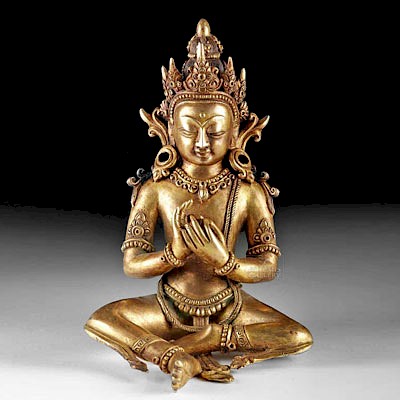18th C. Japanese Edo Copper Tsuba w/ Gilding
Lot 92b
About Seller
Artemis Fine Arts
686 S Taylor Ave, Ste 106
Louisville, CO 80027
United States
Selling antiquities, ancient and ethnographic art online since 1993, Artemis Gallery specializes in Classical Antiquities (Egyptian, Greek, Roman, Near Eastern), Asian, Pre-Columbian, African / Tribal / Oceanographic art. Our extensive inventory includes pottery, stone, metal, wood, glass and textil...Read more
Categories
Estimate:
$1,200 - $1,800
Absentee vs Live bid
Two ways to bid:
- Leave a max absentee bid and the platform will bid on your behalf up to your maximum bid during the live auction.
- Bid live during the auction and your bids will be submitted real-time to the auctioneer.
Bid Increments
| Price | Bid Increment |
|---|---|
| $0 | $25 |
| $300 | $50 |
| $1,000 | $100 |
| $2,000 | $250 |
| $5,000 | $500 |
| $10,000 | $1,000 |
| $20,000 | $2,500 |
| $50,000 | $5,000 |
| $100,000 | $10,000 |
| $200,000 | $20,000 |
About Auction
By Artemis Fine Arts
Jun 6, 2019
Set Reminder
2019-06-06 10:00:00
2019-06-06 10:00:00
America/New_York
Bidsquare
Bidsquare : VARIETY AUCTION | Ancient & Ethnographic
https://www.bidsquare.com/auctions/artemis-gallery/variety-auction-ancient-ethnographic-4182
Around the world & back in time - be amazed at the treasures you will find. Antiquities from Egypt, Greece, Italy and the Near East, Asian, Pre-Columbian, African / Tribal / Oceanic, Native American, Spanish Colonial, Russian Icons, Fine Art, much more! All categories, all price ranges...all legal Artemis Fine Arts info@artemisgallery.com
Around the world & back in time - be amazed at the treasures you will find. Antiquities from Egypt, Greece, Italy and the Near East, Asian, Pre-Columbian, African / Tribal / Oceanic, Native American, Spanish Colonial, Russian Icons, Fine Art, much more! All categories, all price ranges...all legal Artemis Fine Arts info@artemisgallery.com
- Lot Description
East Asia, Japan, middle Edo period, ca. 18th century CE. A finely-preserved copper tsuba of a round (maru gata) form, a disc-shaped hand guard traditionally employed on Japanese swords. The obverse side displays a minimalist nature scene of a gilded bamboo stalk rising up along the right side amongst a sparse field of bamboo leaves on the ground and several more leaves drooping above the top. The reverse exhibits a singular frond of bamboo leaves in the foreground of a rugged landscape. The outer edges of the central blade opening (Nakago-ana) are adorned with four radiating cherry blossoms, with a decorative ovoid hole (Hozuka Hitsu-ana) to the left, and a two-character inscription in-between. A stylish example of superb Japanese artistry! Lucite display stand for photography purposes only. Size: 2.1" W x 2.4" H (5.3 cm x 6.1 cm).
A tsuba is the hand guard of a traditional Japanese sword, usually a katana or tachi. Its primary purposes are to balance the sword, prevent one's hand from sliding down the blade and, as a last resort, as a block against an opponent's thrust or slash. However, as time and skills developed, the tsuba evolved into an artistic item and symbol representing wealth, prestige, or skills as a swordsman. Early tsuba, known as neri tsuba, were made of leather encased in an iron or wooden frame which was occasionally lacquered for strength and stability.
Provenance: ex-private Ft. Myers, Florida, USA collection
All items legal to buy/sell under U.S. Statute covering cultural patrimony Code 2600, CHAPTER 14, and are guaranteed to be as described or your money back.
A Certificate of Authenticity will accompany all winning bids.
We ship worldwide and handle all shipping in-house for your convenience.
#143723Very light abrasions to obverse, reverse, and peripheries, with wear to areas of gilding, and light softening to inscription, otherwise intact and excellent. Nice patina throughout.Condition
- Shipping Info
-
All shipping is handled in-house for your convenience. Your invoice from Artemis Gallery will include shipping calculation instructions. If in doubt, please inquire BEFORE bidding for estimated shipping costs for individual items.
-
- Buyer's Premium



 EUR
EUR CAD
CAD AUD
AUD GBP
GBP MXN
MXN HKD
HKD CNY
CNY MYR
MYR SEK
SEK SGD
SGD CHF
CHF THB
THB













